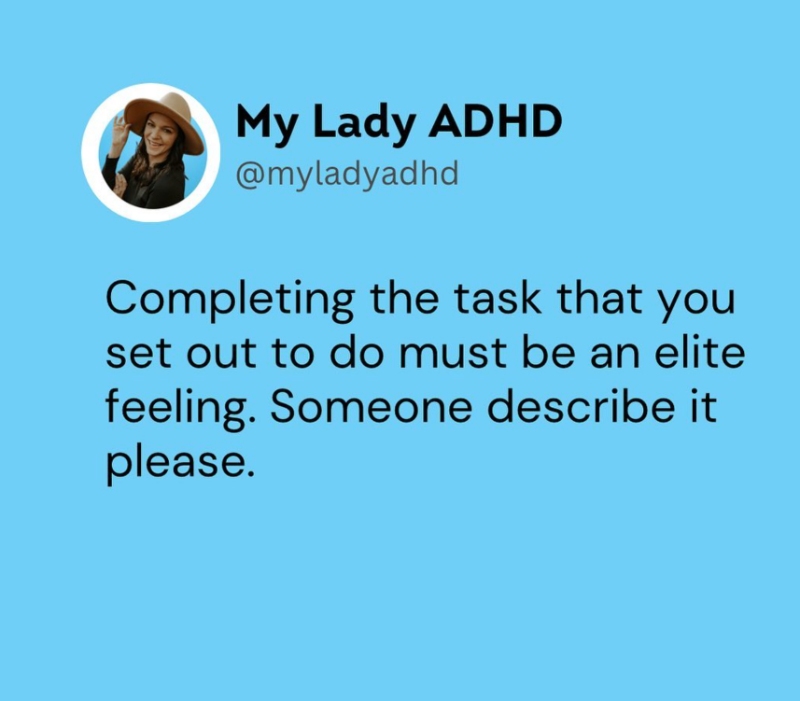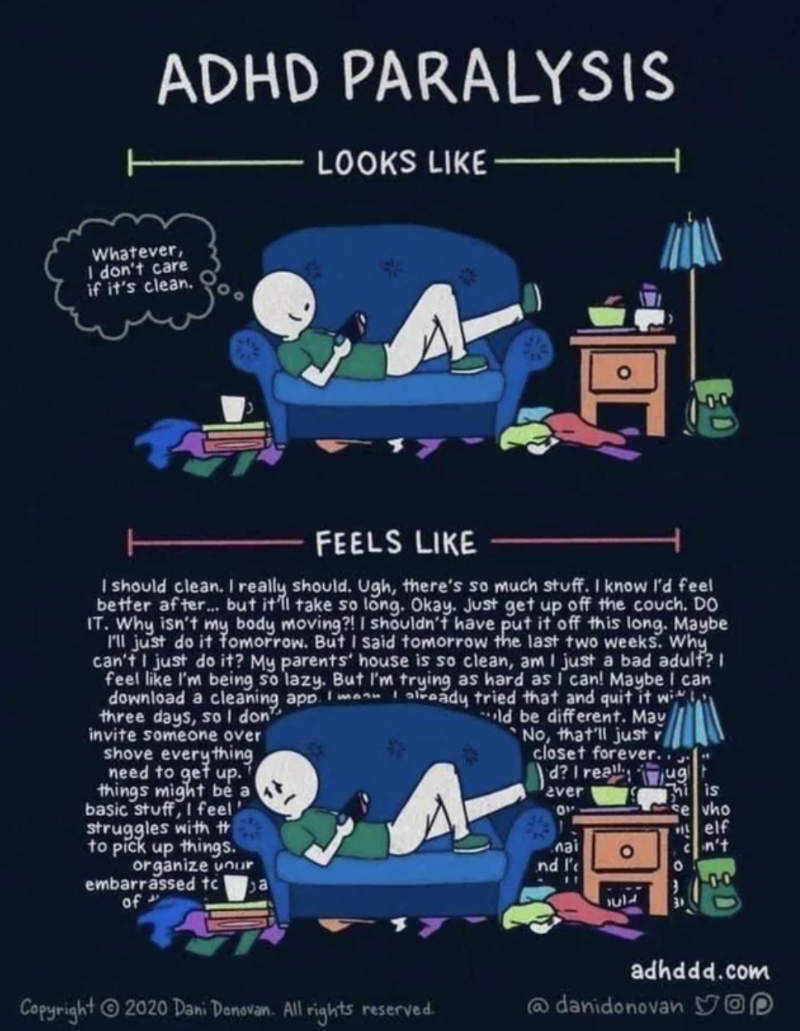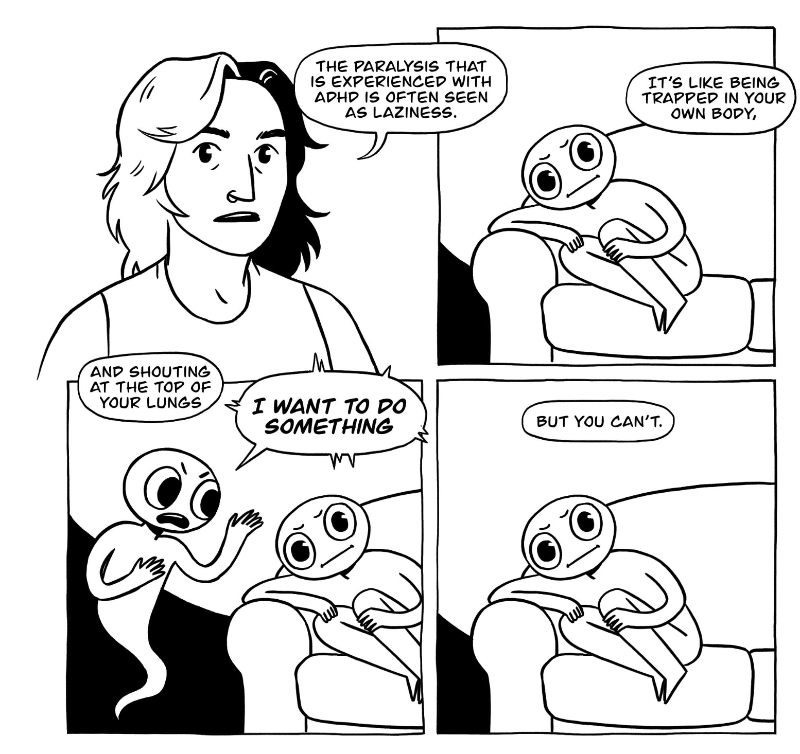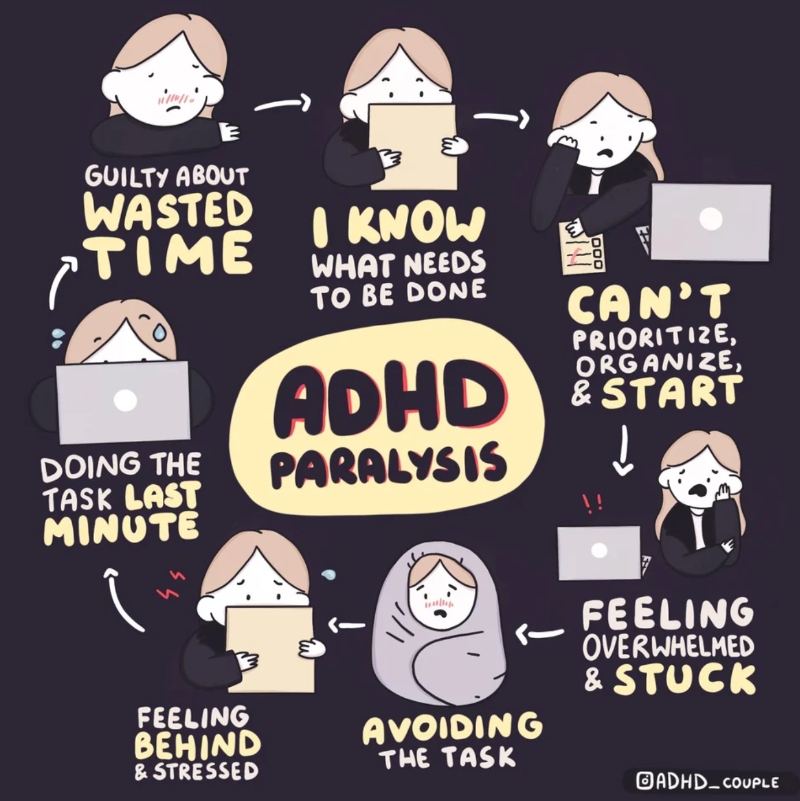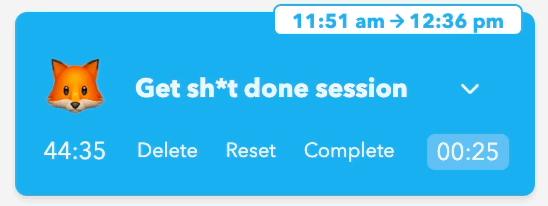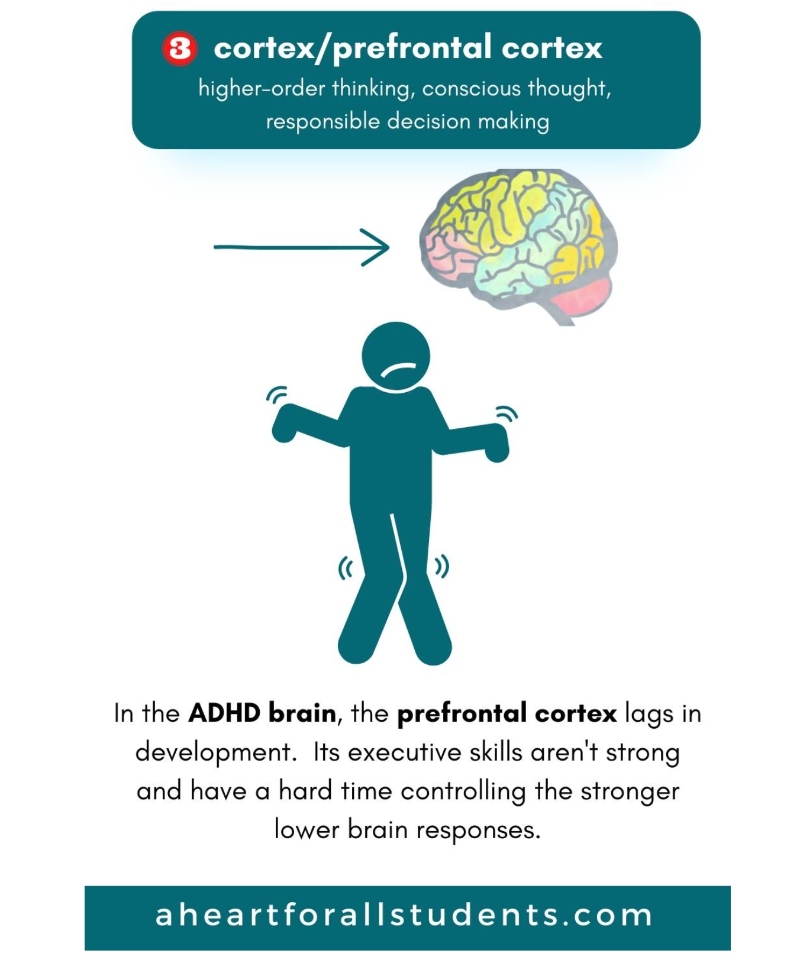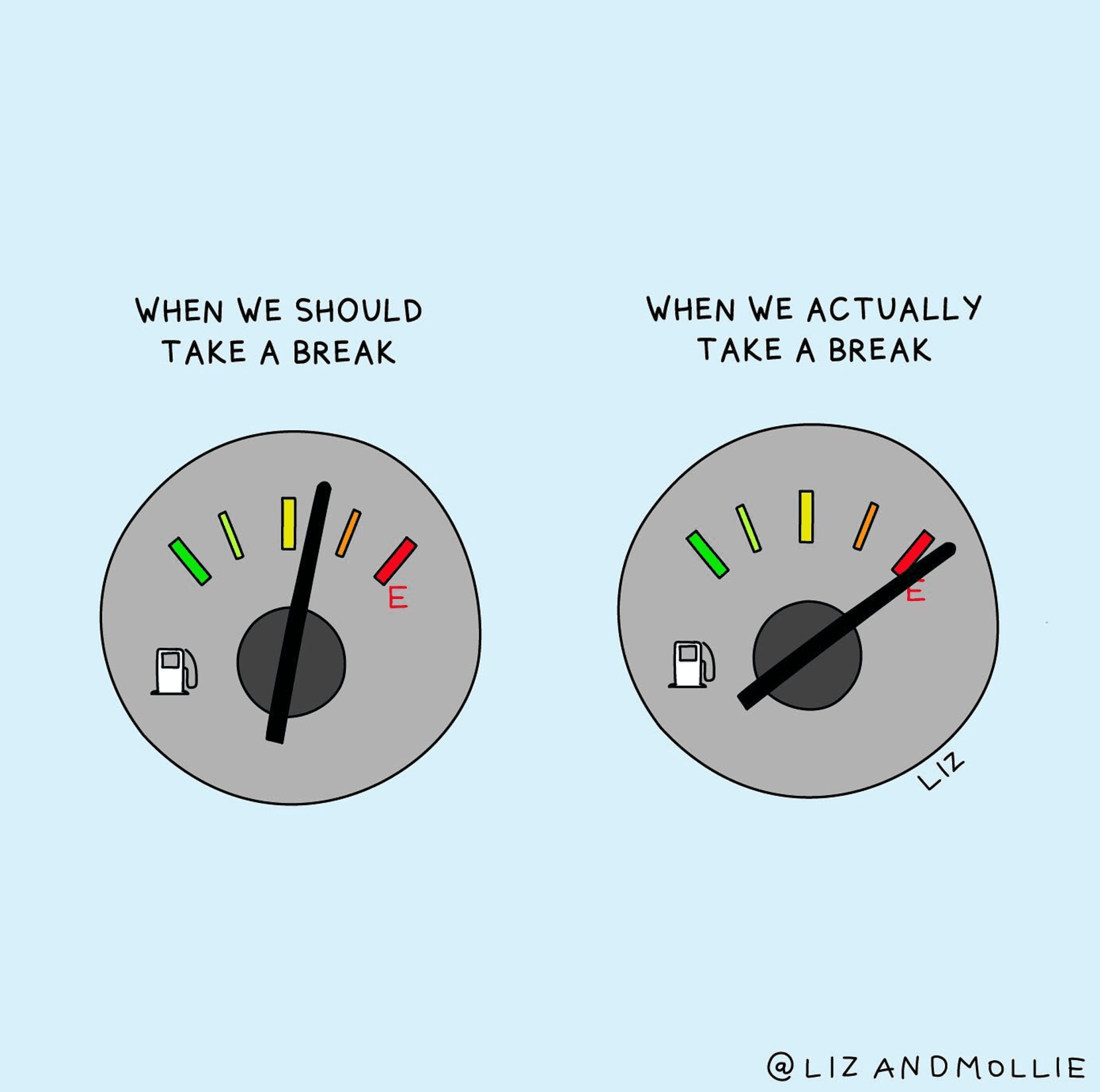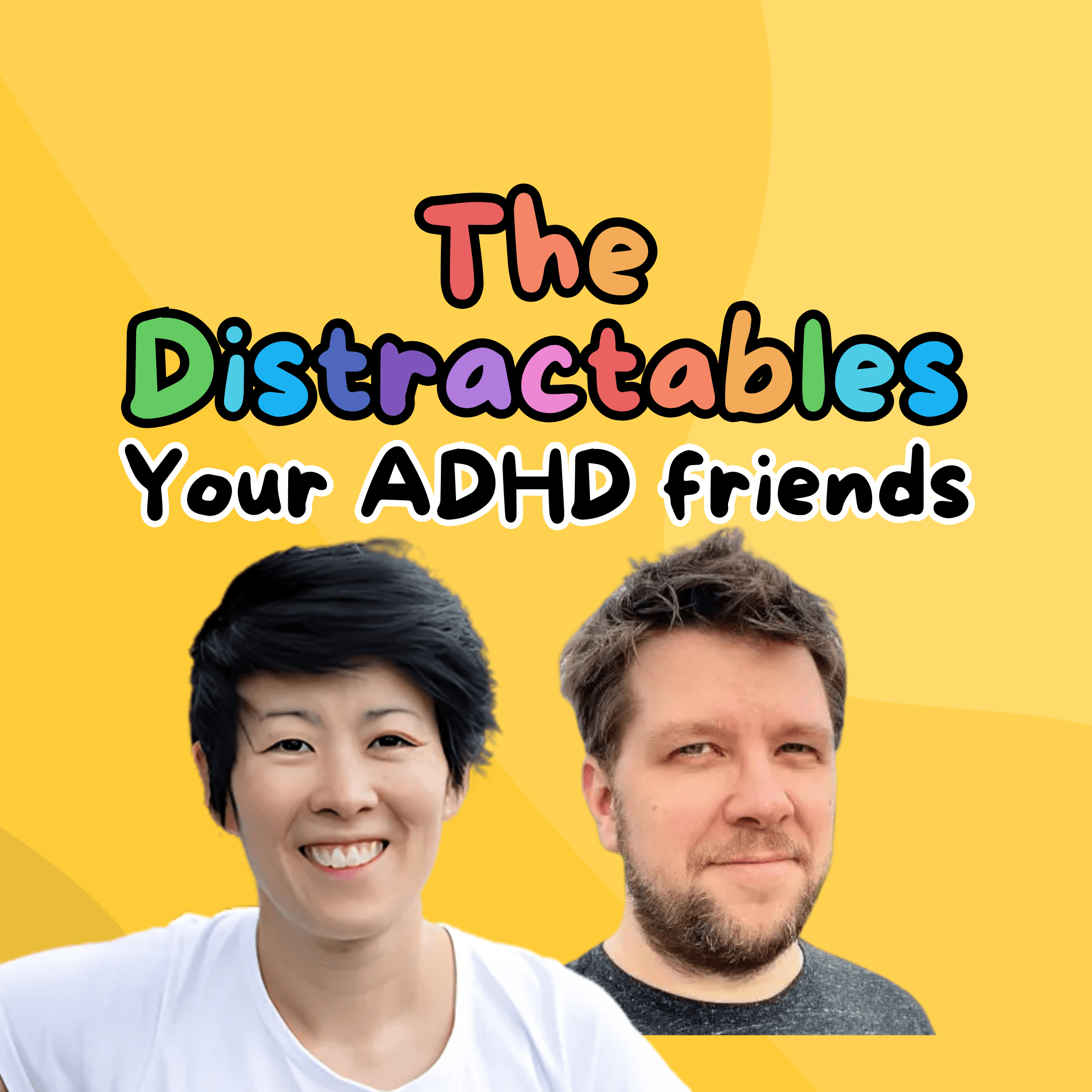Do you often find yourself struggling to complete even the simplest of tasks?
Perhaps you've noticed that you tend to procrastinate, leaving important assignments and deadlines until the very last minute?
Or, are you easily overwhelmed and often find it difficult to focus on one thing for too long?
These symptoms might be signs of ADHD paralysis, a common phenomenon that can leave you feeling stuck and frustrated.
Source: My Lady ADHD
In this article, we'll delve into what ADHD paralysis is, how it relates to ADHD, and some strategies for overcoming it.
Whether you're someone with ADHD, have an ADHDer in your life, or are just curious to find out more about this phenomenon, this article is for you.
In a rush? Scroll to the very bottom for a quick summary!
Source: Dani Donovan
What is ADHD paralysis?
ADHD paralysis meaning
ADHD paralysis refers to the phenomenon of feeling stuck or unable to take action. It's a common experience of those with Attention Deficit Hyperactivity Disorder (ADHD).
Imagine having a bottleneck in your brain that's blocking you from getting motivated and taking action. It's not that your body is actually physically paralyzed, but rather the executive function in your brain is limited in a way that is preventing you from getting the motivation you need to start the task.
Although not an official symptom in the diagnostic criteria for ADHD, ADHD paralysis is widely used to describe the experiences of people with ADHD and the difficulty they have with starting tasks, finishing tasks, or the overall avoidance of tasks all together.
Contrary to what it may seem to non-ADHDers who may not understand the phenomenon, ADHD paralysis is not laziness! It's the result of many differences in the ADHD brain (compared to the neurotypical brain), that causes ADHDers to have difficulty with things like planning, completing multi-step processes, switching tasks, and motivating themselves. Essentially, ADHD brains are wired differently.
It can be hard for non-ADHDers to understand why people with ADHD experience such a difficult time with daily tasks, and as a result can often feel frustrated with the person in their life with ADHD.
Source: Megan K Barry
Because of this, people with ADHD can often experience shame, fatigue, and guilt as a result of their ADHD Paralysis and other ADHD symptoms.
This can cause a downward spiral, causing even more paralysis and shame.
Is ADHD paralysis real?
Yes, it's real! Although the term doesn't mean that the person is physically paralyzed and unable to move their muscles, it refers to a mental state in which someone is unable to motivate themselves to complete a task.
Symptoms of ADHD paralysis
But what might someone experiencing ADHD paralysis feel? Some of the most common symptoms include:
- Avoiding necessary tasks like making doctors appointments, completing assignments, paying bills, or completing chores
- Becoming easily distracted by other things
- Jump from task to task to avoid doing the one they should be doing, and an inability to finish tasks
- Inability to make a decision (until the last possible second)
- Inability to think on the spot or difficulty carrying a conversation
- Decrease self-esteem
- Increased anxiety
- Lack of interest in certain activities
3 types of ADHD paralysis
According to Add.org, there are three different types of paralysis that an ADHDer might experience: mental paralysis, choice paralysis, and task paralysis.
So, what's the differences between these?
Let's explore what these are and how they differ:
ADHD mental paralysis
Mental paralysis occurs when an ADHDer is feeling overwhelmed. This feeling of overwhelm could be due to emotions, thoughts, experiences, information or sensory overload.
A person experiencing ADHD mental paralysis might 'freeze up' during a conversation, or when put on the spot, even if the situation or conversation may seem simple and easy to handle to others, like ordering at a restaurant, or responding to a simple question.
Mental paralysis is like hitting the pause button on your brain, leaving you feeling frozen in place during situations you may find intense. So, if you find yourself zoned out during a heated debate or frozen in fear during a rollercoaster ride, you might just be experiencing ADHD mental paralysis.
ADHD choice paralysis
ADHD choice paralysis, also commonly called 'analysis paralysis', describes the inability for someone with ADHD to make a decision, causing them unneeded stress and mental load. This may occur when you feel that there are too many options to choose from causing you to overthink the situation. You may be afraid that the option you choose will be the wrong choice, or the wrong decision, resulting in overwhelming feelings of anxiety over the decision.
Neurotypical people can also experience analysis paralysis, typically when presented with too many options. However, ADHDers may experience it with just two options, and in situations where the decision may seem obvious, simple or futile to others.
Source: The Mini ADHD Coach
ADHD task paralysis
ADHD task paralysis refers to the sense of dread, fear, or panic that 'paralyzes' someone with ADHD into inaction and hinders their ability to start or engage in tasks that need to be completed.
Perhaps the best way to think about it, is like procrastination on steroids.
It can lead to an intense feeling of overwhelm which can manifest as various mental and physical symptoms... procrastination and task avoidance are often the result.
Task paralysis can be triggered by the anticipation of a big important task, a small mundane task, or a growing and unmanaged to-do list.
The longer the person delays doing the task, the more that the overwhelm and dread grows, causing the paralysis to worsen. It's a terrible negative feedback loop that can cause a downward spiral.
It's not uncommon for people with ADHD paralysis to wait until the very last minute to complete tasks–usually costing them more money (ex. needing to pay for express shipping), energy, (having to stay up all night to finish a paper) and stress.
ADHD paralysis vs. depression
Similar to ADHD paralysis, people experiencing depression may find it difficult to motivate themselves to complete certain tasks or make a decision, and often experience mental freezing or fogginess.
And because 47 percent of adults with ADHD also experience depression, it can be hard to distinguish between the two
The main difference, however, is that while an individual with depression may find it difficult to engage or get started in any task, those experiencing ADHD paralysis typically are still able to start and engage in tasks that they find interesting.
As mentioned, almost half of adults with ADHD experience depression, so it's likely that you could be experiencing both, and that both conditions may be negatively impacting the other.
If you think you are experiencing depression, we highly recommend getting in contact with a mental health professional.
ADHD paralysis vs procrastination
Don't confuse ADHD paralysis with the run-of-the-mill kind of procrastination, where you put off, or delay doing tasks. Think of it as procrastination's evil twin - a debilitating state that leaves you powerless against waves of doubt and dread.
6 strategies for preventing ADHD paralysis before it starts
Have you ever experienced a day where the more you stayed inactive, the harder it became to break out of that cycle?
This is the same reason that once you've experienced ADHD paralysis, it can be hard to get out of.
That often means the more you let it go on, the worse it can get. So it's important to be aware of the triggers, how and why it happens, and have strategies in place to prevent it from happening in the first place.
In this section, we will explore seven effective strategies that can help you combat the effects of ADHD paralysis and regain control over your productivity.
1. Speak with a licensed ADHD healthcare provider
To manage ADHD paralysis, seeking professional help from a licensed healthcare provider is key, but it can be a daunting task.
First, you need to be comfortable with the fact that you may need help and that it's ok to ask for it. And secondly, you need to find a provider and make an appointment.
Finding a provider and making an appointment can feel overwhelming, especially if you're already experiencing ADHD paralysis. It may be worth asking a friend to help support you when you start the process.
Check your health insurance plan's network for providers, or search for them on Psychology Today (USA), ADHD Coaches Australasia, or AADD-UK. Note that while they may not take your insurance, you can still reach out for help.
2. Learn about the ADHD brain to better understand your symptoms
As you've probably already realized, (because you're reading this!), educating yourself about the intricacies of the ADHD brain can be a game-changer in understanding and managing ADHD. And you're off to a great start learning about ADHD paralysis!
We recommend taking the time to learn about time blindness (the inability to feel the passing of time, or know how long things will take), hyperfixation vs hyperfocus, and how dopamine and the prefrontal cortex play a role in executive functioning, cognitive flexibility, and rewards.
These concepts will help you understand what causes ADHD paralysis and position you to better implement strategies to prevent or mitigate its effects.
3. Keep a calendar
Keeping, reviewing and updating a calendar can help to mitigate the potential for feeling overwhelm and experiencing paralysis. Being organized can help to prevent overwhelm by externalizing all the important dates, appointments, and deadlines you have, rather than keeping them all in your brain.
Some ADHDers use a physical calendar on their desk or on the refrigerator. These can be helpful because they serve as a visual reminder where you are likely to see it, reducing the likelihood of forgetting or neglecting important responsibilities.
Others use digital calendars like Google Calendar that integrates with their email. These can work well because they have reminders and helpful alerts and prompts, ensuring you stay on track. Whatever your system is, find one that works for you and integrates with the other tools you use.
Regularly reviewing and updating your calendar helps you stay on top of your obligations, mitigating the potential for overwhelm and paralysis.
4. Learn to listen to your 'gut' or intuition
ADHD individuals often possess a remarkable ability to rely on their intuition or 'gut feelings.' Embracing this innate sense can be an effective strategy to counteract ADHD paralysis.
When faced with decision-making or task prioritization, take a moment to tune in to your intuition. Your subconscious mind may provide valuable insights that can guide you towards the most productive course of action. Trusting your instincts and using them as a compass can help you overcome the inertia that often accompanies ADHD paralysis.
A few tips…
If you find yourself saying "I should...", that's a sign you are trying to meet someone else's expectations. If you find yourself saying "I want.." or "I need..." that's likely your intuition talking.
Here's an audio course that teaches you how to tap into your intuition.
5. Establish a regular exercise habit
Trying to establish a regular exercise habit is easier said than done, we know! But physical activity has been proven to have significant benefits for individuals with ADHD. Engaging in regular exercise releases endorphins, improves focus, enhances cognitive function, and reduces stress levels. These positive effects can help prevent falling into bouts of ADHD paralysis.
Incorporating exercise into your daily routine can provide a natural boost of energy and motivation, making it easier to overcome feelings of inertia. Whether it's a brisk walk, a yoga session, round of golf, or a high-intensity workout, finding an exercise regimen that suits your preferences and interests can greatly enhance your ability to stay motivated and productive.
6. Cognitive restructuring
Cognitive restructuring is a behavioral technique that helps break down automatic patterns of negative thinking.
Individuals with ADHD often struggle with negative self-talk, perfectionism, and profound fear of failure, which can contribute to ADHD paralysis. Cognitive restructuring involves identifying these negative thoughts and replacing them with more positive and realistic ones. By challenging irrational beliefs, reframing negative narratives, and focusing on self-compassion, you can shift your mindset and reduce the likelihood of paralysis.
Seeking guidance from a therapist or using self-help resources on cognitive restructuring can provide valuable tools and techniques for implementing this into your daily life.
Source: ADHD Couple
14 ways to get out of ADHD paralysis once it starts
ADHD paralysis can be incredibly frustrating and overwhelming. The feeling of being stuck, unable to move forward or complete tasks, can be disheartening. However, there are strategies and techniques that can help you break free from the brain fog and regain your productivity. If you find yourself in the grip of ADHD paralysis, try implementing the following tips:
1. Speak with a licensed ADHD healthcare provider
First and foremost, seeking professional guidance is essential when dealing with ADHD. A licensed ADHD healthcare provider can offer valuable insights and personalized strategies to help you manage your symptoms and overcome paralysis. They can provide medication options or suggest alternative treatments that align with your specific needs.
2. Find environments with less distraction
If your current environment is too distracting, try changing your environment in someway. Is there a coffee shop down the street? A park nearby? Can you move to a different room in your house? Changing up your environment could break you out of your funk.
3. Un-isolate yourself and meet with a friend
Connecting with others who understand and empathize with your ADHD struggles can be immensely beneficial. Whether they have ADHD themselves or are familiar with it, find a friend you can share your struggles with. Sharing your experiences and challenges with someone who can relate can help alleviate feelings of isolation and shame which might free you up to actually get started on some of the tasks.
Another great option to consider is to join an Accountability/Co-working group. Some great options include Shelpful, Focus Friends Club, Numo, and the Accountable Otters Club.
4. Try 'Get Sh*t Done' sessions
At Llama Life, we have 'Get sh*t done' sessions, where the team comes together virtually to tackle tasks in a supportive environment. These sessions provide accountability and create a sense of camaraderie, helping break through paralysis and accomplish your goals.
5. Use timers and other time management tools
Time management is crucial for individuals with ADHD. Utilize timers to structure your tasks and allocate specific time intervals for focused work. Set achievable goals for each session, and take short breaks in between to recharge your focus. A tool like Llama Life will make using timers really easy and fun (you may even get some confetti for completing a task 🎉).
6. Get moving!
Exercise is just about the answer for everything these days, and its often way easier said than done, especially when you're in a paralysis state.The key is to start small–seriously, just raise your hands above your head five times, or walk up and down the stairs–or find something you enjoy (like walking with a friend, playing basketball, etc.) Anything that sounds fun to get the blood flowing will stimulate your brain and increase your alertness.
7. Embrace sunlight
Sunlight plays a vital role in regulating mood and energy levels. Spending time outdoors, especially in the morning, can help reset your circadian rhythm and improve your overall wellbeing. Try to incorporate outdoor activities into your daily routine, such as taking a walk or sitting in a sunny spot while working.
8. Fuel your brain with protein and dopamine-boosting foods
Want to turbocharge your brain function? You need to eat right! When ADHD paralysis strikes, reach for a protein-packed snack to give your dopamine levels a boost. Why? Dopamine is key for motivation and focus. Think eggs, nuts, lean meats, and beans to increase dopamine availability in your brain and get more done. And don't forget tyrosine - it's essential for dopamine production and can be found in many protein-rich foods. So start your day with a breakfast that fuels your brain and watch your productivity soar!
9. Journaling - put pen to paper
Writing down your thoughts and emotions can be therapeutic and help clear your mind, but sometimes journaling seems daunting. Who wants to stare at a blank page? The trick is to just start writing or doodling anything that comes to mind. It doesn't matter what ends up on the page. Just go with the flow and capture whatever comes to mind.
10. Consider ADHD stimulant medication
If you haven't already, consult with your healthcare provider about the potential benefits of ADHD stimulant or prescription medication. These medications can help improve focus, attention, and overall executive functioning. However, it's essential to work closely with a healthcare professional to find the right medication and dosage for your specific needs.
11. Embrace novelty in your approach and environment
ADHD brains thrive on novelty and new experiences. When you feel paralyzed, try injecting some novelty into your routine or workspace. Rearrange your desk, try out a different productivity app, or experiment with new techniques to complete tasks. Breaking away from monotonous patterns can ignite your motivation and spark creativity, helping you overcome ADHD paralysis.
12. Gamify your tasks
Turning tasks into games can be an effective strategy to combat ADHD paralysis. Set up a point system for completing specific tasks and reward yourself for reaching a certain number of points (for example, maybe a desert once you finish 3 tasks).
13. Race against the clock
Setting timers for each task can be a fun way to create a sense of urgency and prevent you from becoming overwhelmed by the vastness of a task. By working in focused bursts, you can gradually regain momentum and overcome ADHD paralysis. Llama Life is a great tool for this!
14. Be kind to yourself and embrace your neurodivergence
It's essential to practice self-compassion when facing ADHD paralysis. Recognize that ADHD is a neurodivergent condition, and that your brain works differently.
Embrace your unique strengths and abilities that come with ADHD, such as creativity, hyperfocus, and out-of-the-box thinking. Use these strengths to your advantage and develop strategies that cater to your specific needs. By embracing your neurodivergence, you can cultivate a positive mindset and find effective ways to navigate through paralysis.
Source: ADHD Alien
ADHD scrolling paralysis - what does it mean and how to prevent it?
Scrolling paralysis refers to the state of being entrapped in a continuous cycle of mindless scrolling through digital content, typically on social media platforms, without any purpose or meaningful engagement. It is characterized by an inability to break away from the constant allure of endless feeds, resulting in time wasted, decreased productivity, and heightened feelings of frustration and overwhelm.
The impact of scrolling paralysis on individuals with ADHD
For individuals with ADHD, scrolling paralysis can be particularly debilitating. The inherent difficulties in maintaining focus, regulating attention, and managing impulsivity make ADHDers more susceptible to getting caught in the vortex of mindless scrolling. The instant gratification and novelty provided by digital platforms act as powerful stimuli, triggering a dopamine rush that further exacerbates the struggle to disengage. This vicious cycle often leads to increased procrastination, diminished self-esteem, and decreased overall productivity.
Preventing scrolling paralysis
One creative solution suggested by someone on Reddit: when checking your phone to do a quick task, get into a squat position so that when your legs get tired, its a reminder to get off your phone!
You could also time your social media breaks using Llama Life, which would be a less painful method!
Remember, breaking free from scrolling paralysis is not an overnight process, but with patience, perseverance, and the right tools, it is indeed achievable.
Executive function and the causes of ADHD paralysis
The role of the prefrontal cortex
The prefrontal cortex is responsible for higher-order thought, responsible decision making, and executive functioning, a term for the set of mental processes that enable us to plan, organize, focus attention, regulate emotions, and make decisions.
In other words, the prefrontal cortex is our main center for critical thinking, and acts as a layer of rational thought above the emotional parts of the brain, allowing us to control impulses, set goals, and manage time effectively.
Executive dysfunction in Attention Deficit Hyperactivity Disorder
However, in individuals with ADHD, the development of the prefrontal cortex differs from that of non-ADHD individuals. Specifically, the frontal cortex, including the prefrontal cortex, has been shown in studies to develop at a slower pace in ADHD brains compared to controls (Shaw et al. 2009a).
This delayed development affects the individual's ability to regulate and manage emotional responses originating from the lower brain regions.
Other studies have shown that adolescents and adults with ADHD have less brain activity in parts of the brain during reward anticipation, which can hinder the ADHD brain to successfully motivate itself to complete tasks.
These changes, among others, contribute to executive dysfunction in ADHD patients and affect decision making, cognitive flexibility, motivation, time management, and reward anticipating, which create the conditions for ADHD paralysis.
Source: A Heart for All Students
In conclusion, ADHD paralysis can be a difficult challenge, but there are ways to find relief and manage its effects. If you find yourself struggling to cope, do not hesitate to reach out for help and referrals. Specialized resources such as counseling, ADHD Coaches, education and support groups can help you get the additional support you may need.
In summary:
- Although ADHD paralysis is not an official symptom in the diagnostic criteria for ADHD, it is a real phenomenon that is experienced by many ADHDers
- ADHD paralysis is the feeling of being stuck or unable to take action. Imagine a bottleneck in your brain that's blocking you from getting motivated and taking action. Your body is not actually physically paralyzed
- It can be hard for non ADHDers to understand why people with ADHD experience paralysis, which can often result in feeling frustrated
- Common symptoms of ADHD paralysis include avoiding necessary tasks, being easily distracted, jumping from one task to another, an inability to make decisions or think on the spot, decreased self esteem, increased anxiety and lack of interest in certain activities
- There are 3 types of ADHD paralysis: Mental paralysis, choice paralysis, and task paralysis
- There are many strategies you can put in place to try to prevent ADHD paralysis, including speaking with a licensed ADHD healthcare provider, using a calendar, exercising and looking after your health, and trying to listen to your 'gut'.
- Once experiencing ADHD paralysis, there are many recommended ways to get out of it, including: speaking with a licensed ADHD healthcare provider, connecting with friends and others for support and accountability, using timers and other time management tools, looking after yourself by exercising regularly and eating right, gamify or adding novelty to your tasks, and to be kind to yourself.
- The prefrontal cortex is responsible for higher-order thought, responsible decision making, and executive functioning, a term for the set of mental processes that enable us to plan, organize, focus attention, regulate emotions, and make decisions.
- In individuals with ADHD, the prefrontal cortex has been shown in studies to develop at a slower pace compared to controls. This delayed development affects the individual's ability to regulate and manage emotional responses originating from the lower brain regions.
